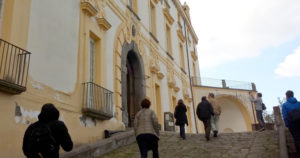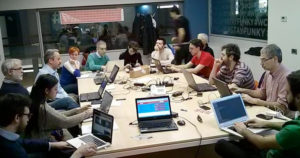It has been a long journey made of an infinite amount of phone calls, hoping for someone to respond. “Confiscati Bene” is two years old because it is a project that promotes transparency, civic monitoring and open data which had been created from the exchange of ideas of about ten people and it has grown until it became a community that cooperates, exchanges information, carries out advocacy, promotes events and conventions on the topic of assets seized from crime.

Il primo monitoraggio civico nel castello di Ottaviano a Napoli
Today, it has among its ranks also journalists, Public Administration officials, Libera Association volunteers or volunteers from other associations and cooperatives engaged in the fight against mafia and the social reuse of the assets seized from the clans.
READ MORE: “Riprendiamoli”, 24 Journalist and Two Years of Hard Work: the Making of
The idea to involve citizens in monitoring villas, palaces and lands seized to mafiosi was born in the spring of 2014 as a spin-off of another transparency project: OpenPompei. With a notebook and camera in hand, civic hackers entered for the first time in the facilities of Radio Siani, in Ercolano, and in the Medici Castle of Ottaviano, both located in Campania. These are two places that once were symbols of camorra’s power, which in the ‘80s in those same premises schemed, planned murders or counted bribe money.
READ MORE: “Riprendiamoli”, Mafia Bosses’ Ferrari Cars
“We were about ten people, and among them some from Monithon, that for some time had already started to talk with the Agency for the seized assets about the publication and use of the data,” says Andrea Borruso, who between 2013 and 2014 was selected for the Open Pompei project in the role of open data expert. “In that occasion I had the opportunity to know better Alberto Cottica (project manager of OpenPompei, ndr) who proposed me to organize a hackathon (a marathon that calls for the use of data, ndr) on the assets seized and to carry out during the meeting of the Spaghetti Open Data community 2014.” The Agency data were updated only up to January 2013, they were not complete nor reusable. After about ten hours of work, the first database was created. “Towards the end,” adds Borruso, “excited and happy for what we were able to accomplish, we asked ourselves a question: ‘how do we call this project?’ and Massimo Santi answered: ‘Confiscati Bene’.”
That collection of ideas and above all of data could not dissolve at that time so the confiscatibene.it website was created with the technical contribution of Twinbit and the journalistic contribution of Dataninja.
If there is something that civic activism and investigative journalism have a commone skill: being a pain in the neck. They are determined to seek information, putting pressure on institutions and other sources with all available tools, from request for civic access all the way to confirmation in the field.
READ MORE: “Riprendiamoli”, Confiscated Goods: Your Alerts
Confiscati Bene became then a journalist investigation on data, published simultaneously in 2014 on “L’Espresso” online and 18 local newspapers of the Group. On the www.confiscatibene.it website were disclosed data on seized assets at the national, regional or municipality level in addition to those on directors threatened by organized crime, Municipalities dissolved because of Mafia infiltrations. “Seek for the data and you’ll find the stories” was the project’s motto so that the stories of how the State was reacquiring, even if with difficulties, a heritage of billions of Euros built on foundations of drug trafficking and weapons, corruption, money laundering and extortions, did not have to rely solely on numbers and maps. From the investigation were born parliamentary questions, degree theses, and even local events. The email of a farmer from the province of Caserta, who asked us information on how to manage a seized lot of land in his area, which had been abandoned until then, was the confirmation that the “potential energy of the seized assets” had not only to be released but also communicated, both in Italy and abroad.

Il raduno 2015 di Spaghetti Open Data
Therefore, in the fall of 2014, Dataninja virtually flew to Brussels, getting financed by the JournalismFund for a European-wide investigation to inventory the seized assets and find out where they were located and how many they were across the continent, and if the various nations had acquired them, as Italy did. On December 16, 2015, the investigation “Confiscated goods: the dark billions” was broadcast simultaneously in Italy, France, Spain, Germany and UK. The investigation looked into the four billion Euros of assets confiscated in Europe, on the money laundering activities of Italian bosses in the Iberian peninsula and Cote d’Azur and featuring also the scandal of the villa seized in France to a Calabria-base loan-shark connected to ndrangheta. The villa remained available to him for years, to the point that he could rent it online on Airbnb. Even in this case, the Italian media outlet was “L’Espresso”.
Over the months, three-thousand documents were collected, information was exchanged and reviews performed with foreign colleagues, meetings investigators took place along with judges and representatives of the national Agency for seized and confiscated goods as well as representatives from the anti-mafia national directorate and experts in foreign seizures abroad.
READ MORE: “Riprendiamoli”, the Challenge for Confiscated Goods
In the meantime, Confiscati Bene was rewarded with awards and recognitions: a special mention by the ISTAT, the Wind Transparency Awards, the mention into the Shortlist of the Open Data Awards 2015 in the category “Open Data Social Impact Award – celebrating open data used as a tool for social good.”
The rest of story brings us forward to today, with stage two of the project and a new publication date set for March 21, on occasion of the national day dedicated to the victims of mafia crimes. An organization called onData was born to support the initiatives of Confiscati Bene. The organization promotes transparency and data culture through digital skills and investigative journalism. In addition to the divulgation of data, the organization promotes digital storytelling on the “new life” of the seized assets by supporting the film festival “Corto di Sera”, which will award the best short films on confiscated goods in a special section called “Ripreso Bene”. onData is partner of Libera, the NGO that in 1996 was the architect of the approval of the law for the social reuse of seized assets, in a project that would map out all of the over 23 thousand confiscated goods, and through the creation of a network of “sentinels” across the territory that will monitor if they are really being confiscated well. (gdm)
Translated by Marion Sarah Tuggey